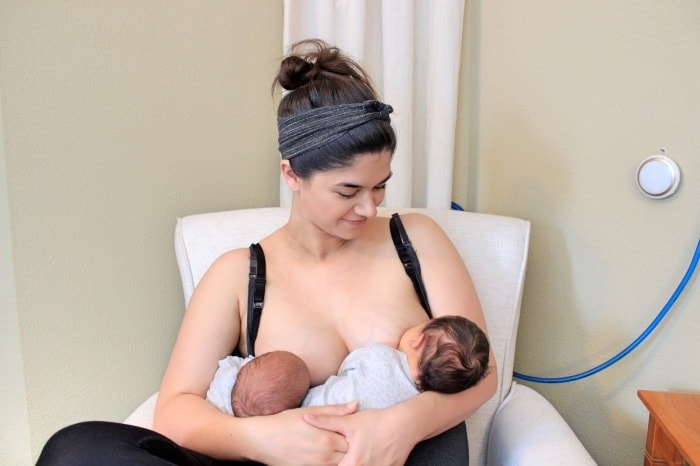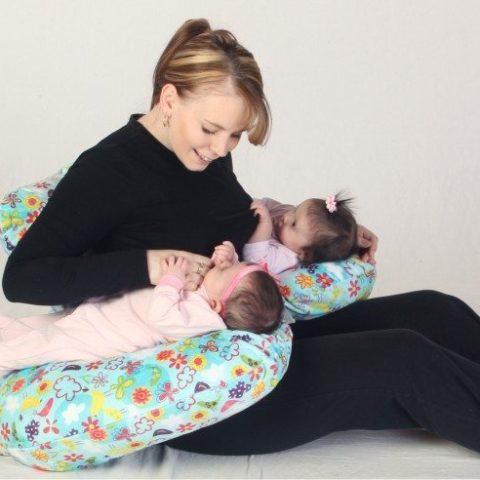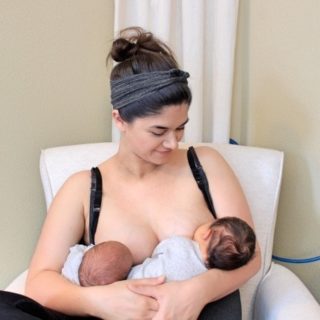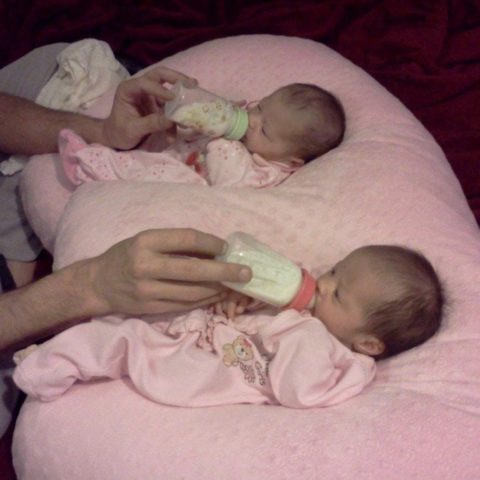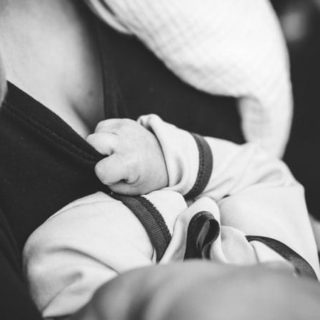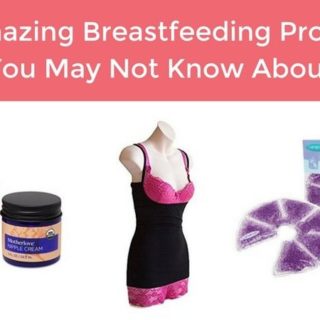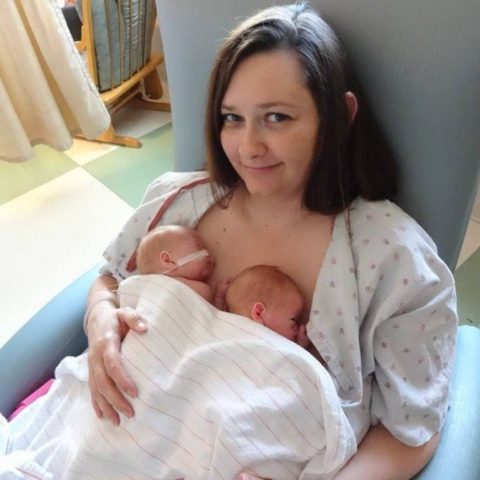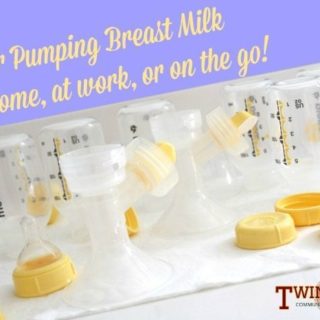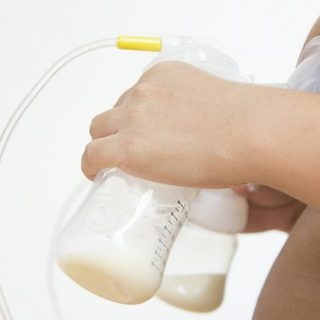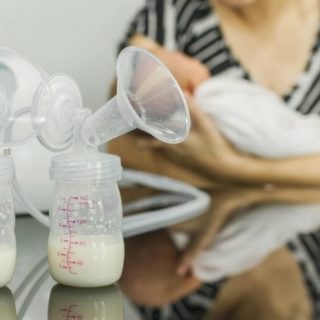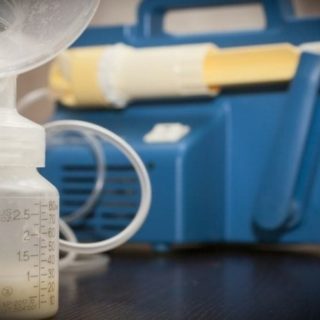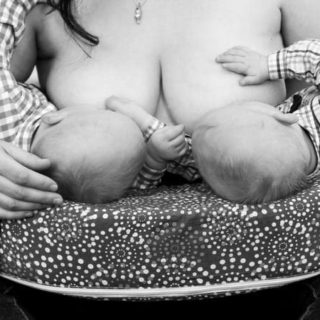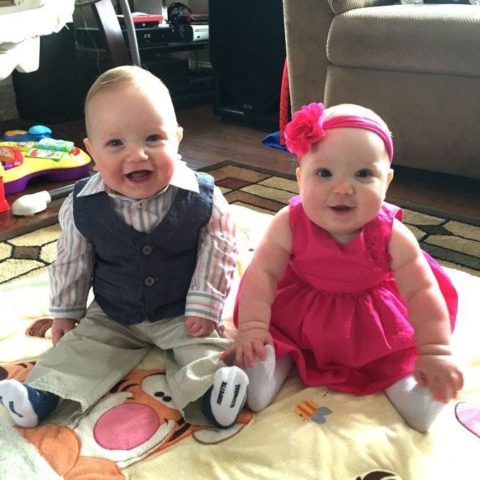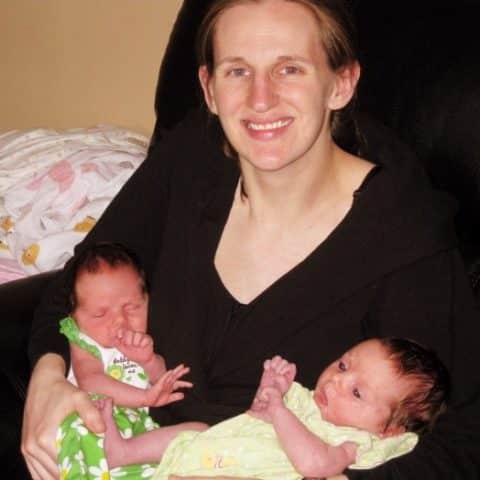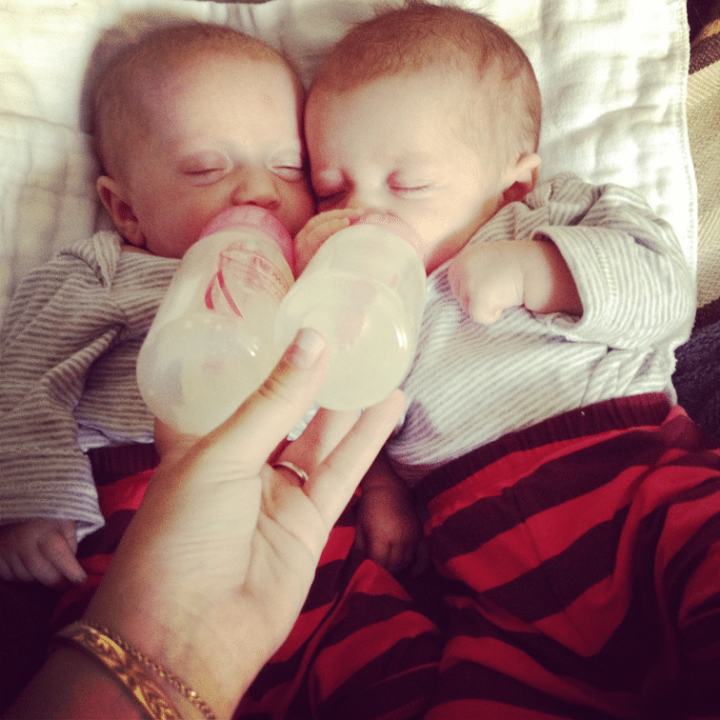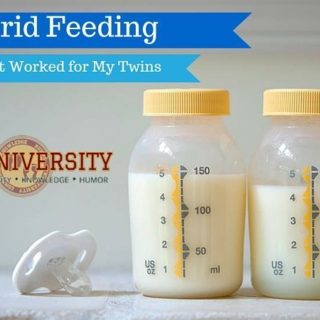Last updated on July 22nd, 2024 at 06:34 pm
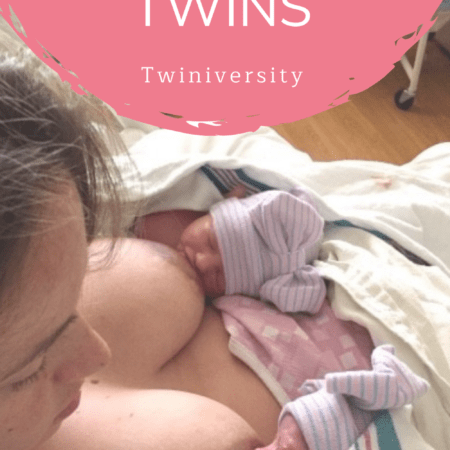


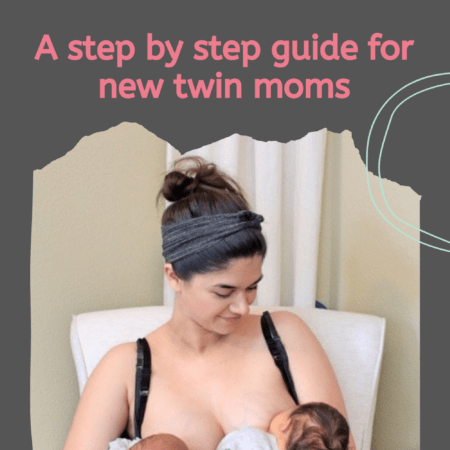
Are you currently breastfeeding your twins, or still expecting twins and wondering how you will be able to feed your duo? Good news, Twiniversity is the #1 source for twins breastfeeding information and we are here to help.
- How to Breastfeed Twins
- The Basics of Breastfeeding
- Why Is Breastmilk So Great?
- You Might Need to Supplement With Formula
- What is the Magic Hour?
- How Do You Properly Latch a Baby?
- Does Breastfeeding Hurt?
- How Do I Manage Breastfeeding Twins During My Hospital Stay?
- How Often Should I Breastfeed My Twins?
- Establishing a Twin Nursing Schedule
- How Long Should a Breastfeeding Session Last?
- How to Increase Your Milk Supply for Twins by Pumping
- Pumping Tips for Moms of Twins
- How Can I Prepare for Breastfeeding Twins?
- What Supplies Do I Need for Breastfeeding?
- Finding Support for Breastfeeding Twins
- Will I Produce Enough Milk for Two Babies?
- How Much Milk Do My Twins Need Each Day?
- What I Can Do to Make Breastfeeding Twins Easier?
- What if My Twins Are Unable to Breastfeed?
- Should I Feed My Twins Together or Separately?
- I’m Struggling With Breastfeeding Multiples: What Should I Do?
- Looking After Yourself
- Mixed Feelings About Breastfeeding Twins
- Different Positions for Tandem Breastfeeding Twins
- Breastfeeding and Working Full Time
- How Many Calories Do You Need a Day to Breastfeed Twins?
- How Long Should I Breastfeed Twins?
All content on this Website, including medical opinion and any other health-related information, is for informational purposes only and should not be considered a specific diagnosis or treatment plan for any individual situation. Use of this site and the information contained herein does not create a doctor-patient relationship. Always seek the direct advice of your doctor in connection with any questions or issues you may have regarding your health or the health of others.
How to Breastfeed Twins
Breastfeeding twins can be a challenge, especially if your babies were born prematurely, but yes, even then it’s totally possible. Most moms will be worried about whether you have enough milk to go around and how to keep up with the demand. Your friends and family are probably offering advice that doesn’t always mix with what you want to do. And pumping at work might be more complicated than you imagined it would be. And maybe you’ve already breastfed a single baby and you’re wondering how it will be different with twins.
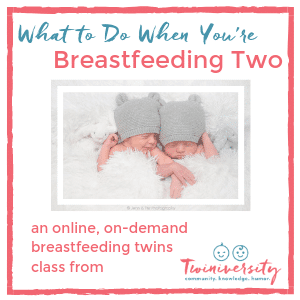
Worried about breastfeeding twins? What To Do When You’re Breastfeeding Two is an on-demand online breastfeeding twins class made just for YOU! This course was created by Twiniversity in partnership with Judy Teibloom-Mishkin, IBCLC. Click here to learn more…
The Basics of Breastfeeding
Before we get started on the specifics of breastfeeding twins, let’s cover the basics of breastfeeding.
While you’re pregnant, your breasts are filling up with colostrum, the first form of milk that your babies will get. Colostrum is yellow and sticky and full of good nutrients, vitamins, and antibodies that will help protect your babies while their immune systems are still developing. This “pre-milk” or “newborn milk” is packed with everything your babies will need to stay nourished.
When your babies are born your placentas are delivered. The delivery of the placenta is what triggers breastfeeding to begin. So it doesn’t matter if you have a C-section or a vaginal delivery.
Milk will start being produced immediately after your delivery. Prolactin and oxytocin are released, and the body is getting ready to start breastfeeding. Once you start to nurse or pump, the colostrum comes out first. Colostrum will be your babies’ food for the first few days of life.
Within three to five days after birth, colostrum will be replaced by transitional milk. This milk is thinner, higher in volume and calories, and includes high levels of fat, water-soluble vitamins, and lactose.
Mature milk is the final milk that is produced, starting around two weeks old. Mature milk is comprised of water, carbohydrates, proteins, and fats which are necessary for both growth and energy.
Nursing is beneficial on so many levels. Not only does it provide food to your tiny duo, but it also helps shrink the uterus back to its normal size. Lactation professionals recommend that breastfeeding should start as soon as possible after delivery, ideally within the first 1-to-2 hours if possible, but we know that with twin deliveries, that’s not always possible, but we will help you with that so don’t worry.
For most breastfeeding moms, breastfeeding begins in the recovery room after birth. However, when you’re having twins, you will most likely deliver in the operating room, and you may be having a C-section. If both mom and babies are healthy after delivery, breastfeeding can begin immediately with the help of your partner and the nurses in the OR if your hospital is open to the idea. You can place your babies skin to skin on your chest even if you can’t have them latch immediately and your milk-making triggers will be set into action.
Are You a New Twin Parent?
Check out Natalie Diaz’s book:
“What To Do When You’re Having Two
The Twin Survival Guide From Pregnancy Through the First Year”
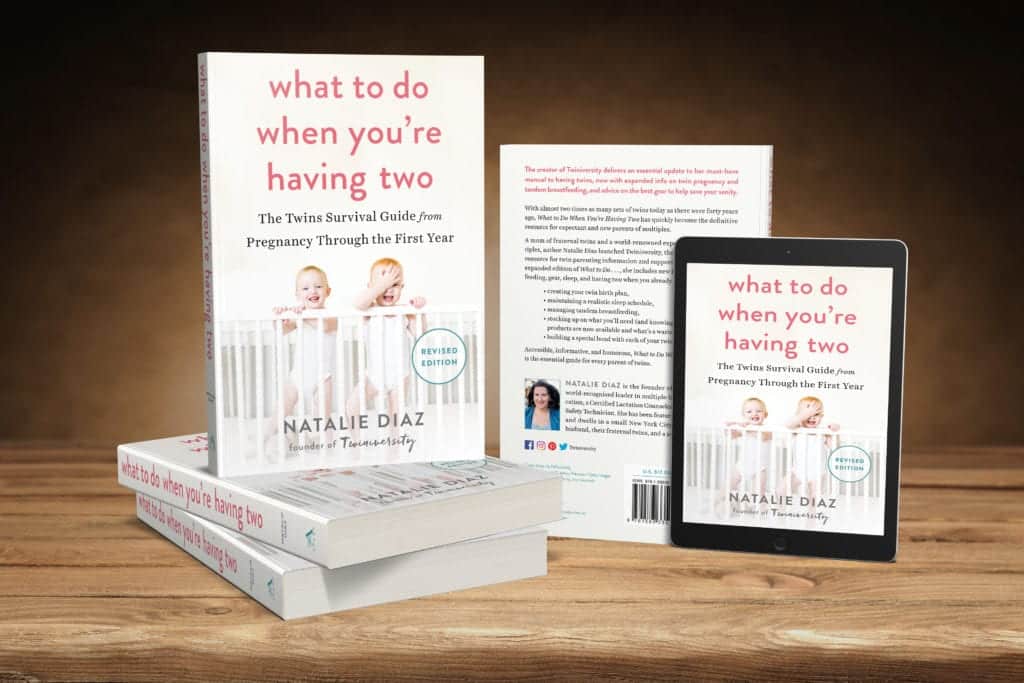
In What to Do When You’re Having Two: The Twins Survival Guide from Pregnancy Through the First Year, national twins guru and founder of Twiniversity (and twin mom herself!) Natalie Diaz provides a no-holds-barred resource about life with twins, from pregnancy and birth all the way through your duo’s first year of life.
Accessible and informative, What to Do When You’re Having Two
is the must-have manual for all parents of twins.
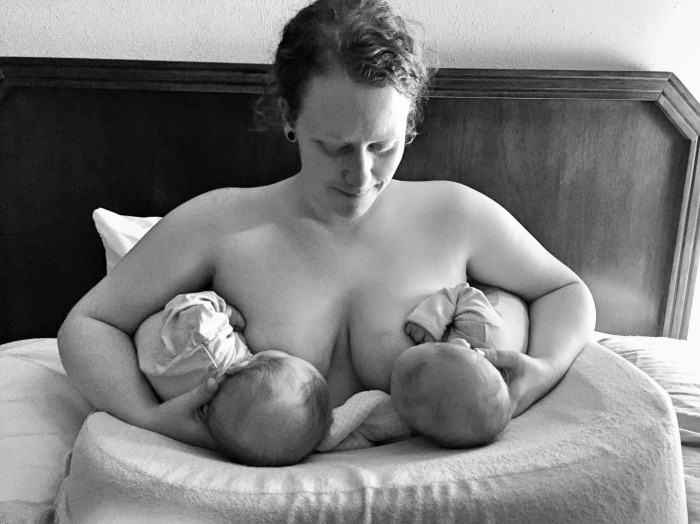
Why Is Breastmilk So Great?
- Breastmilk is the perfect food for your growing baby because it was made JUST for them. Your breastmilk will be different than any other breastmilk since it’s formulated specifically for your babies.
- Breastmilk has everything your twins need to survive and thrive, including antibodies that protect them from illness.
- Breastmilk changes as babies grow, based on your baby’s needs so it’s always the right formula.
- Breastmilk can be easily digested by breastfeeding babies, even those who are premature because it contains prebiotics for their healthy gut, but also prebiotics that helps protect their tiny immune system.
- Breastmilk is always available at the perfect temperature and consistency, and breastfeeding moms are often able to make as much as their babies need.
- Breastfed babies have lower incidences of ear infections, asthma, and other childhood illnesses.

Worried about breastfeeding twins? What To Do When You’re Breastfeeding Two is an on-demand online breastfeeding twins class made just for YOU! This course was created by Twiniversity in partnership with Judy Teibloom-Mishkin, IBCLC. Click here to learn more…
You Might Need to Supplement With Formula
Even though breastmilk is the ideal food for your baby, that doesn’t mean formula is the devil! We are actually fans of formula here at Twiniversity. Formula is a fantastic option if your babies need extra supplementation or if breastfeeding is just not working out for you. It’s really OK to give your babies formula! We promise. Remember, you are trying to feed TWO BABIES AT ONCE. This is a gargantuan feat! It’s a 24/7 job to breastfeed twins. If you’re able to give your twins 100% breastmilk, then you go girl!! But if you can’t, you are SO not alone. This is VERY common with moms of twins and multiples. But just know that ANY breastmilk that you can give your twins will benefit them greatly, whether it’s one day of milk or one year of milk. Every! Drop! Counts!
What is the Magic Hour?
According to breastfeeding research, breastfeeding in the first hour after birth is pretty important. It’s called “the magic hour” or “the golden hour”. That first hour is important because your babies are getting used to the new world they were released into. Remember, when they were in utero it was the absolute perfect universe for them. Once born, it’s a big adjustment for them and for you. That first hour is also when a new mother has a giant release of oxytocin which causes her uterus to contract and helps stop the bleeding. Oxytocin is also one of the main faucets to turn your breastmilk on. So having the babies near, ideally, nursing would be awesome. Your twin’s sucking will trigger a release of oxytocin which ROCKS since this “love hormone” will help you relax and help you bond with your babies. The sooner we can begin this love feast, the better.
During the Magic Hour, babies can also have a spike in their blood sugar levels when they nurse which they will need because one to two hours after delivery, their glucous levels start to dip. So if you can grab them in the magic hour, you can get ahead of that dip.
Breastfeeding within the first hour after birth can also help establish breastfeeding. Surveys show that moms who can breastfeed that first hour will have an easier and longer breastfeeding journey. BUT that doesn’t mean you won’t be a totally awesome breastfeeder if you DON’T have them during that time. Having two babies does complicate things, trust us, we know. Also, our deliveries aren’t always, shall we say, ideal. But the sooner you can have skin-to-skin with one or both babies, go for it! Just make sure to have plenty of people nearby to help assist. Here is a great video on the magic hour:
Now, let’s get real for a second, if you’re unable to breastfeed one or both babies within the first hour or two, don’t freak out! It’s ok. There is still a lot you can do to get breastfeeding off on the right foot. Twiniversity highly recommends that you bring a spoon with you in your hospital bag so you can hand express colostrum into it if your babies are not there or are unable to latch. This expressed colostrum can be fed to the babies by an oral syringe. Make sure that you have everyone on board, your partner, the nurses, and anyone that can help get this first milk to your babies. If your twins are in the NICU, your partner and the nurses can help deliver and feed this early milk. This happens often in the hospital, so don’t worry about how they might react.
If you, for whatever reason are unable to be with your twins during the Magic Hour, is it possible for your partner to be there? Skin-to-skin with the babies helps the bonding process, and also helps them regulate their heartbeats, and regulate their body temperatures.
If you end up needing to hand express breastmilk, watch this video on how to do it:
How Do You Properly Latch a Baby?
Most new moms go into breastfeeding with the idea that latching is natural and will just happen. Sure, that can happen, but in our experience, this is not always true. Breastfeeding is a skill that has to be learned. There are so many things that can be wrong with a latch, and the latch is where this whole journey begins. An improper latch can cause nipple pain, improper suction, and most importantly poor transfer of milk from mom to baby.
We are going to back up for a minute and tell you WHY it’s important to have a real good latch. Did you know that your baby doesn’t PULL the milk out of you, but rather shapes your nipple. Once your nipple is in the ideal shape, oxytocin, one of the most important hormones in any new mom’s life, will release milk INTO your baby’s mouth. The latch is what will help create that perfect shape and your body will do the rest. That’s how a teeny tiny baby can breastfeed. Even if they are early if they can latch, they can help shape your nipple and they don’t have to do much else. So yeah, we need a good latch.
You want to make sure that your baby has not only a good latch but a deep latch. If your baby is only attached to your nipple, they will only get a small amount of breast milk because remember, they need to shape it, to get it to release the milk. Believe it or not, the majority of your areola should be in your baby’s mouth with your nipple pointed up towards the roof of their mouth towards the rear where it’s soft.
Do this for me right now: Take your tongue and run it from behind your teeth towards the back. Do you feel how it softens halfway back? That’s where your nipple needs to go. If your latch is shallow, it will hit that hard spot behind the teeth, and OUCH! Yeah, we need it to go back further.
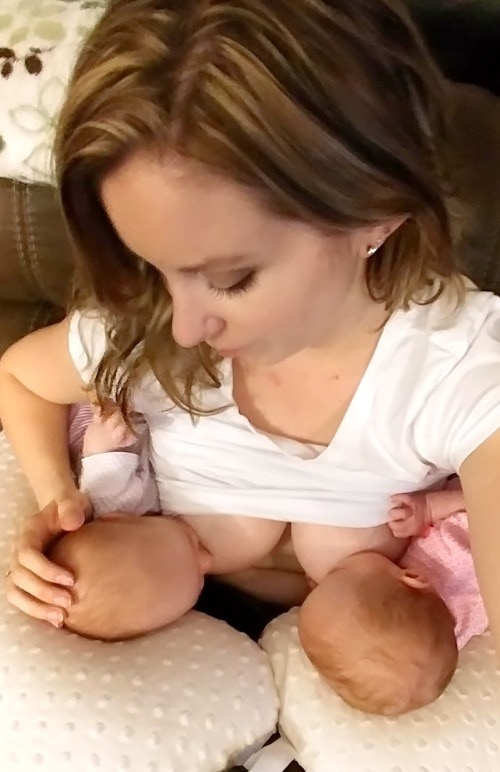
There’s a breastfeeding rhyme that will help you learn the proper positioning for a great latch:
“Tummy to mummy, Nose to nip, Flex the hips to open the lips”
Let’s break this down.
“Tummy to mummy” means your baby should have their tummy right up against your tummy so you are snuggling up together very closely with your skin touching their skin when possible.
“Nose to nip” means that when you bring your baby to the breast, you should point your nipple at their nose. This will allow your baby to smell the milk glands on the nipple.
“Flex the hips”: Your baby’s ears, shoulders, and hips should be in alignment. There should be no pressure against the back of the baby’s head so they can tilt the head back and move freely, which will help with latching. Support the baby by their neck instead.
“To open the lips” have your baby 1-3 inches away from the breast, which done after the other steps will cause your baby to gape, opening their mouth very wide as their head tilts back and get the best position and best seal. If your baby doesn’t gape, try this again. Then quickly move the baby forward toward your breast. The tongue and lower lip should seal first to the breast and the upper lip should seal next.
Watch this video to learn how to hold your baby in a comfortable position:
This is a fantastic video to learn how to properly latch a baby for a good, deep latch. Please go watch this video and keep it bookmarked so you can refer to it whenever you need a refresher:
Does Breastfeeding Hurt?
Breastfeeding should never hurt. If breastfeeding hurts, there is probably something wrong with the latch. Before your nipples get too sore or even crack, and you want to quit altogether, call a lactation counselor and have them observe a feeding virtually or in person. Nat is available for all twin parents out there. You can find information on her twin lactation counselor services.
Any lactation counselor will be able to give you great advice and help to latch properly and stop the pain! If you are having nipple pain, watch this video for some quick latching tips without pain:
How Do I Manage Breastfeeding Twins During My Hospital Stay?
Your breastfeeding experience during your hospital stay is dependent on a number of factors:
If you and your twins are separated after birth, you will need to rely on hand expression and pumping to get your supply started. All of this expressed milk can be sent down to the NICU and fed to your babies to make sure they are getting that “liquid gold” to help build their immunities and gain back the weight they will lose after childbirth.
If your twins are doing well and they can room in with you, which will allow you to catch their early feeding cues and start feeding them together on the same schedule. Don’t worry at this point about tandem breastfeeding (that’s nursing two babies at once). It’s not very common for both babies to nurse simultaneously this early in the process. You can totally try it, because it’s one of those amazing things that twin moms only get to do, but we recommend that you wait to try tandem nursing until each baby is confident at the breast. This could take days to weeks. Don’t rush it, and feel free to give it a try now and then, especially when you have an extra set of hands to help out.
If you have one twin in your room and one twin in the NICU, do your best to nurse the twin that is with you and also pump for the other twin to have your milk in the NICU. The lactation consultants at your hospital can help you rent a hospital-grade pump to get maximum output. You can pump on your other breast while you nurse your baby or use a Haaka to collect the let down while you’re nursing. In the hospital though, renting isn’t necessary, they will loan you a pump while there and provide any parts necessary.
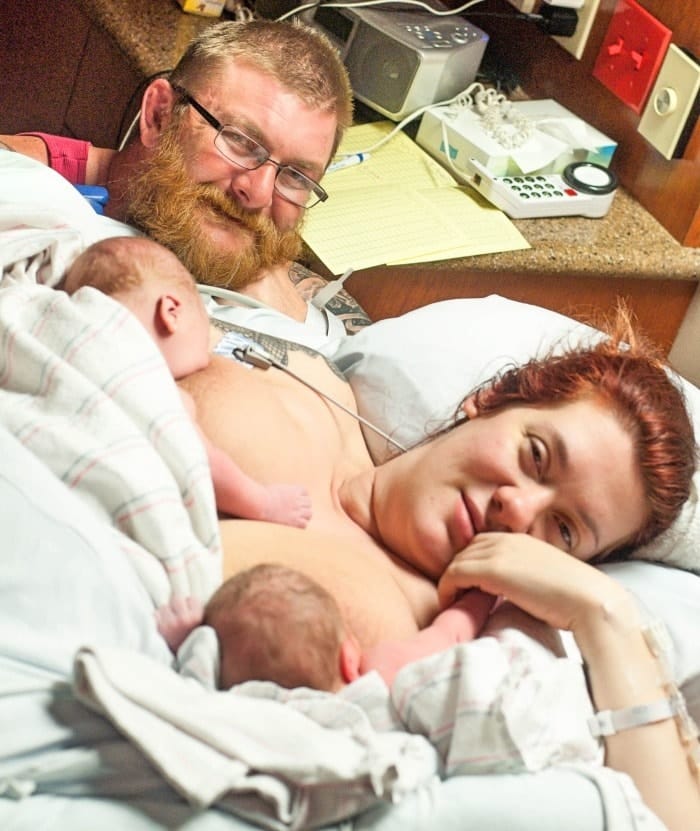
If you need a break from your babies so you can get some sleep, do not feel bad! Ask the nurses if they can take the twins to the nursery, if available, so you can rest. Your babies will be OK! This is the only time when you will have around-the-clock care, so use the help if you need it and don’t think twice. You will have PLENTY of time to bond with your babies once you are feeling healthy enough to do so.
We recommend you limit visitors when you are in the hospital. The time you have in the hospital is so crucial for establishing breastfeeding and getting rest. Don’t feel bad at all about asking your loved ones to wait until you and the babies are home to visit. If you want to have visitors, make sure you’ll feel comfortable around them while breastfeeding. Your breasts will be out a LOT while you’re in the hospital, and it may be awkward to have your dad or Uncle Herb in the room at the same time. If you would like to limit visitors, discuss this with family before so they don’t feel rejected. You’ll need their help later, so feel free to tell them “I took this twin breastfeeding class, and the instructor told us it’s important to use the hospital time to learn and recover. Will you be ok if we just meet up with you when we get home?” Put the blame on Twiniversity. We will always be the bad guy if you need us to. Families don’t often understand, and their excitement can get the best of them. So set your boundaries in the beginning so you can tell the breastfeeding story you’d like in the future.
One last tip for the hospital: Ask for a lactation counselor or consultant to visit you as soon as possible in your room and really utilize their expertise while you’re an inpatient.
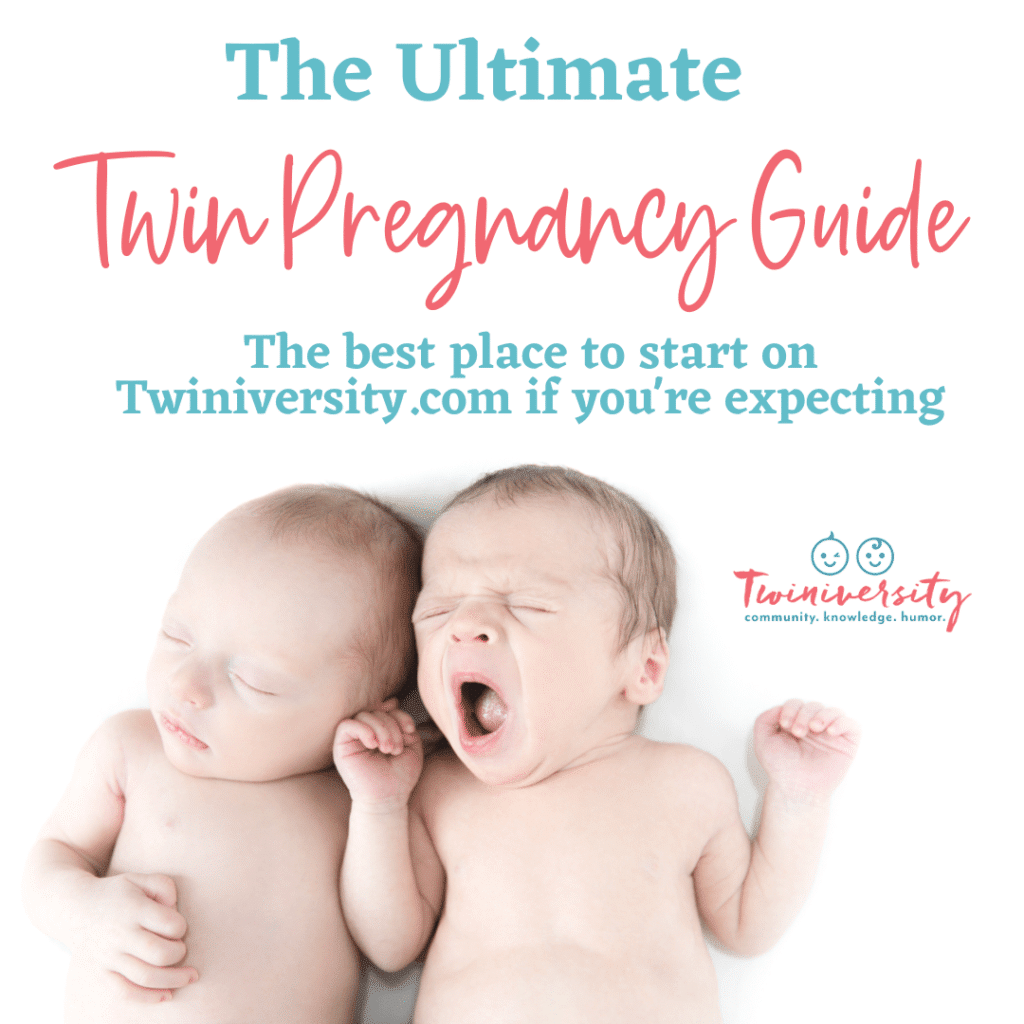
Pregnant with twins and not sure where to start? Visit the Ultimate Twin Pregnancy Guide to find all the top articles and resources to get you ready for twins. While you’re at it, check out our expecting twin classes and Twiniversity shop!
How Often Should I Breastfeed My Twins?
It is recommended that you nurse your baby at least 10-12 times a day and at the very minimum eight times a day. The more opportunities you have to put your babies to breast, the more oxytocin you’ll release and the sooner you’ll heal AND establish a better supply. Babies’ stomachs are so tiny when they are born (about the size of a marble); that’s why they have to feed so often, they can’t hold a lot. However, feeding two babies 10-12 times a day is extremely exhausting, and you have to find a good balance to make sure you’re not putting your own health and well-being at risk. Breastfeeding isn’t only physically demanding, it’s emotionally demanding. It’s a very tricky balancing act that takes time and patience to master like any other skill you have to develop.
Establishing a Twin Nursing Schedule
For moms having one baby, it is recommended to feed on-demand; this means that whenever the baby is showing feeding cues, such as rooting, REM eye movement, and bringing hands to mouth, that you should feed the baby. This is not always realistic with twins, especially if you have older children at home.
At Twiniversity, we recommend putting your twins on a 3-hour feeding schedule as soon as possible which is what many twin moms are on since it’s the same schedule at the NICU.
Having them on a breastfeeding schedule means that your babies will always eat at the same time and sleep at the same time. This is our recommendation because feeding your twins on-demand is extremely difficult and stressful. That doesn’t mean it can’t be done. However, we have found that the majority of our twin moms and dads fare better when putting their twins on a schedule. They are able to get more rest and manage life at home with twins easier.
However, this might not be your style, and that’s OK! Every mom is different, every set of twins is different, and your family’s situation is also unique. You need to do what you need to do to survive, as long as everyone is safe.
We suggest introducing a bottle early on so your partner or another caregiver can also feed the babies. If you have another adult with you that can help with feedings, this is ideal; breastfeed one baby (and pump the other breast) while the other adult gives a bottle of your pumped milk. Then at the next feeding, switch babies. Read more about how your partner can help when you’re nursing twins. And learn breastfeeding tips for dad here.

Need some twin parent friends? Get the support you need with a Twiniversity Membership. Benefits include a monthly twin parent club meeting on Zoom, access to a private Facebook group just for twin parents, and a video library of twin parenting lessons. Visit Twiniversity.com/membership to join today!
Here is a sample breastfeeding schedule for newborn twins:
- 5:45 am wake and change diapers
- 6 am feed
- 6:45 am pump
- 7:30 am nap
- 8:45 am wake and change diapers
- 9 am feed
- 9:45 am pump
- 10:00 am tummy time
- 10:30 am nap
- 11:45 am wake and change diapers
- 12 pm feed
- 12:45 pm pump
- 1:00 pm tummy time
- 1:30 pm nap
- 2:45 pm wake and change diapers
- 3 pm feed
- 3:45 pm pump
- 4:00 pm tummy time
- 4:30 pm nap
- 5:45 pm wake and change diapers
- 6 pm feed
- 6:45 pm pump
- 7:00 pm put them to bed
- 8:45 pm wake and change diapers
- 9 pm feed
- 9:45 pm put them to bed (for nighttime feedings, barely wake them to eat and put them back down right after they are done eating)
- 10 pm pump
- 11:45 pm change diapers
- 12 am feed
- 12:45 am put them to bed
- 1:00 am pump
- 2:45 am change diapers
- 3 am feed
- 3:45 am put them to bed
- 4:00 am pump
For more week-by-week schedules for infant twins, visit our First Year with Twins Timeline.
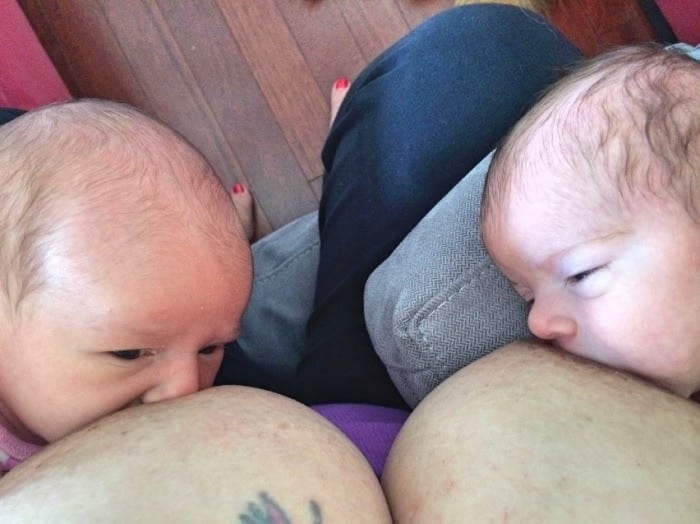
How Long Should a Breastfeeding Session Last?
Your baby should be able to get a full feeding at your breast within a 20 minute period. But sometimes, feeding may only last a few minutes. It is perfectly normal for babies to lose interest in breastfeeding after only a few minutes and want to switch to the other breast! Once your twins become more efficient breastfeeding at the breast (at around 1-month-old), they should be able to get their fill in about 10 to 15 minutes. If you need to feed one baby at a time (which is very common in the early days and weeks), soothe the other baby with a pacifier while they wait or have someone else bottle-feed that baby with either pumped breastmilk or formula. Once your babies are good at tandem breastfeeding, this will cut down on your feeding times and give you more time to get things done and rest.
How to Increase Your Milk Supply for Twins by Pumping
In the early weeks, it can be hard to increase your milk supply for twins. The key to remember is that it’s all about supply and demand. The more frequently you remove milk from your breasts, the more your breasts will produce milk. If you don’t nurse or pump at least every 3 hours, your supply will start to dwindle. You don’t need to pump for very long each session — just 15 minutes is enough. Another important thing to remember: It’s not about how MUCH you pump; it’s about how OFTEN you pump. You’re training your body to create enough milk for two babies. Frequent removal of milk will signal your body to make more milk.
In the early days/weeks of breastfeeding twins, pumping for 10-15 minutes after you nurse your babies will help to boost your supply. If you really need to boost or maintain production, make sure to pump in the middle of the night when your prolactin is at its highest. Once your supply is well established (by 4-6 weeks), you can stop pumping on a schedule.
Pumping Tips for Moms of Twins
Invest in 3 or 4 good hands-free pumping bras. These bras will allow you to pump without having to hold the flanges to your breasts. If you don’t have a hands-free pumping bra, you will literally have to sit there holding them with both your hands, and it’s super annoying!
Look into hands-free pumps, such as the Freemie, Willow, Elvie, Medela Freestyle Flex, and Baby Buddha. These pumps are battery-powered and fit right inside your bra or on a lanyard around your neck so you can move around the house while pumping. This is fantastic for moms of twins who need to maximize their time. You can literally clean the house or make dinner while pumping!
It’s important to make sure your breast pump flanges fit properly too. The standard breast pump flange size only fits about 45% of women. You may need a size up or a size down. This all depends on the size of your nipples, not the size of your breasts. You could have large breasts but small nipples, which would require a smaller flange. Or you could have small breasts with large nipples and need a larger flange. If your pump comes with several size flanges, try them out to see if you get better output. Remember, your pump should be latching on your entire nipple, not just the portion that sticks out. The tunnel of the flange should surround your nipple closely but leave enough space for it to move back and forth freely without rubbing against the sides. The flanges shouldn’t chafe or pull too much of your areola (that’s the dark area around the nipple), or the breast around it, into the tunnel as you pump.

Need a plan for the first week home with twins? Book your 60-minute twins \post-delivery strategy session on a video call with Lauren Oak, Twin Expert and Certified Postpartum Doula (and mom of twins!), to create a customized game plan for you and your twins when they come home. Click here to learn more… and while you’re at it, check out our Twiniversity Shop and Twin Parent Memberships.
Take some time before your babies arrive to read your pump’s instruction manual. You’ll need to learn how all the buttons work, especially the buttons for the letdown phase. Most electric breast pumps have two phases, the first which mimics the way your baby feeds, starting with fast, light sucking (this is called the letdown phase) followed by slower and stronger sucks to help trigger your let-down. To help stimulate your milk flow, massage your breasts before and during pumping, and apply a warm compress to your breasts before expressing.
If possible, do some skin-to-skin contact with your twins before and during pumping, which scientists have found can help you express more milk. The warmth and touch of your baby’s skin against yours releases oxytocin to help stimulate milk production. If your twins aren’t with you while you’re pumping, try looking at photos or videos of them, or smelling some items of their clothing, to help your letdown.
Power pumping is another technique to try to jump-start your supply quickly. Your power pumping session should look like this: 20 minutes pumping, 10-minute break, 10-minute pumping, 10-minute break, and one final 10-minute pump (totaling 60 minutes). This should happen only once a day, unless otherwise instructed by your doctor or lactation consultant, over a period of time so that engorgement doesn’t occur. Read this great article on power pumping for more details. We think it will help a lot.
Here’s a fun fact: You don’t need to wash your pump parts after every use! Put everything in a gallon Ziploc bag and keep it in the fridge. Wash and sterilize them once a day. Easy peasy! BUT they must be stored in your fridge that is maintaining at least a temp of 40 degrees or lower.
Want to know breastmilk and formula storage guidelines? Download the printable from our Etsy shop.
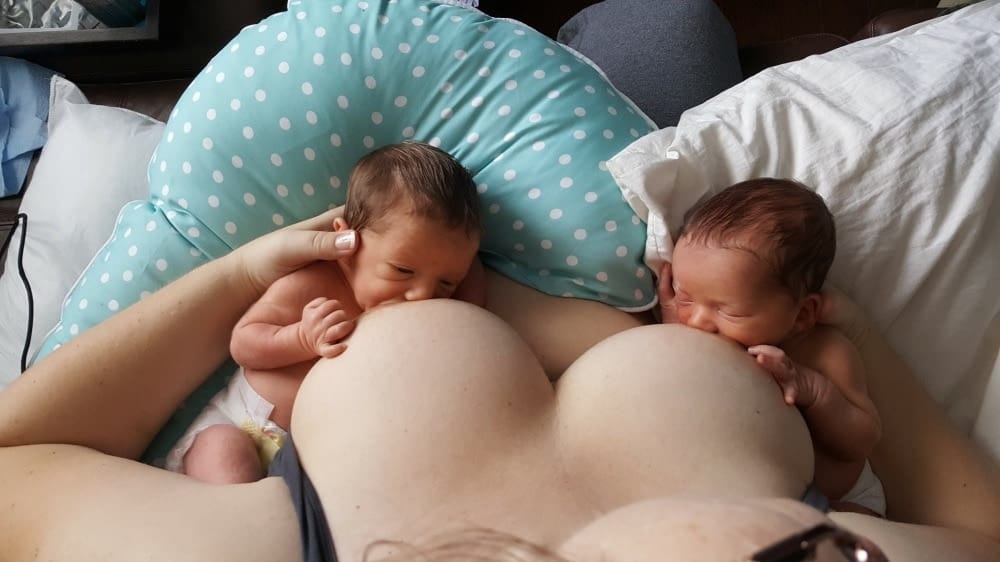
How Can I Prepare for Breastfeeding Twins?
- We highly recommend that you take our breastfeeding twins class to prepare for breastfeeding your twins. This class is taught by an IBCLC (international board-certified lactation consultant) who specializes in twins, and you can take the class on-demand any time of the day or night.
- Start interviewing local lactation professionals to find someone that shares your same philosophies on breastfeeding, and has some twin experience. Have this person ready to go before you deliver and plan for a home visit from them in the first week at home.
- Another great resource is booking a lactation consultation with our resident CLC (certified lactation counselor) and Twiniversity founder Natalie Diaz. She can help you create a plan for breastfeeding twins in the hospital and at home and help you navigate any breastfeeding challenges that come up along the way.
- Nursing twins is a 24/7 job, and you should prepare yourself mentally for this. This doesn’t mean you should be discouraged from nursing your twins; just set realistic expectations so you don’t get burnt out and frustrated quickly. While tandem nursing is a huge timesaver, expect that your twins may have a hard time getting the hang of this for the first 2-3 months. Plan to nurse each baby individually until they are both latching and eating well, and then tandem feeding will be more successful.
What Supplies Do I Need for Breastfeeding?
There are some breastfeeding supplies you’ll want to buy during your pregnancy to get ready for breastfeeding twins:
- twin breastfeeding pillow
- single breastfeeding pillow (these are helpful for bottle feedings too)
- nursing bras
- pumping bras
- nursing tanks/camis
- double electric breast pump
- milk storage bags
- extra set of pump parts
- twins baby tracker app or a notebook – make sure to download the Twiniversity App!
- nursing pads
- nipple cream
Read the list of all our top baby gear.
Call your health insurance and ask what breastfeeding supplies are covered under your plan. Many insurance companies will cover accessories for breastfeeding, such as milk storage bags and extra pump parts. Go through the above list with the representative to make sure you know what is covered and what is not, as well as the process for getting reimbursed for these items. Breastmilk is a medical necessity for preemies and your health insurance will probably cover more than you think they will! Also please note that if you ever need a special baby formula because of a medical need (such as a higher calorie formula for preemies) your insurance will probably cover this as well.
Finding Support for Breastfeeding Twins
Get your support system prepared and ready. You’re going to need support from your partner, family, and friends to help boost you up when you need it. Make it clear how important it is to you that you breastfeed your twins and make sure your support system is on board with your plan. Establish rules on what you do and don’t want to hear from them.
If you’re not finding support in your own circle, start looking for outside support. Get a lactation counselor for more support. Consider hiring a postpartum doula to get more specialized help at home with your twins. Join a breastfeeding group at your local hospital or pediatrician’s office. Find your local twins club and go to a meeting to find other moms like you. Twiniversity has a twin parent membership where you can connect with twin moms and dads from all over the world to get breastfeeding support from other twin families who have been there.
Will I Produce Enough Milk for Two Babies?
Most moms of twins are able to produce enough breast milk for two babies. Start breastfeeding as soon as you can after birth to help establish your supply sooner than later. If your supply is dwindling, add in some pumping sessions to boost your supply. Herbal supplements that promise to boost supply are not guaranteed to work and often don’t. Focus on milk removal to increase supply.
How Much Milk Do My Twins Need Each Day?
How much breastmilk your twins need each day will vary greatly, depending on their current weights, if they are preemies, how old they are, and other factors. It’s also difficult to tell how much breastmilk your babies are eating. Pay attention to these points to determine if your babies are getting enough breastmilk. Please note: these rules may differ for premature babies; check with your doctor.
- Baby should start gaining weight by day 5 of life
- Baby should be back at birth weight by two weeks old
- Baby should be gaining about 1 oz per day
- Baby should produce 4 stools daily by day 4 of life
- Baby should produce a minimum of 6 wet diapers daily by day 4/5
- Stools should be matte and yellow; shiny stools indicate tummy problems; green and voluminous stools indicate that feedings are too fast/too much and you may have an oversupply of milk
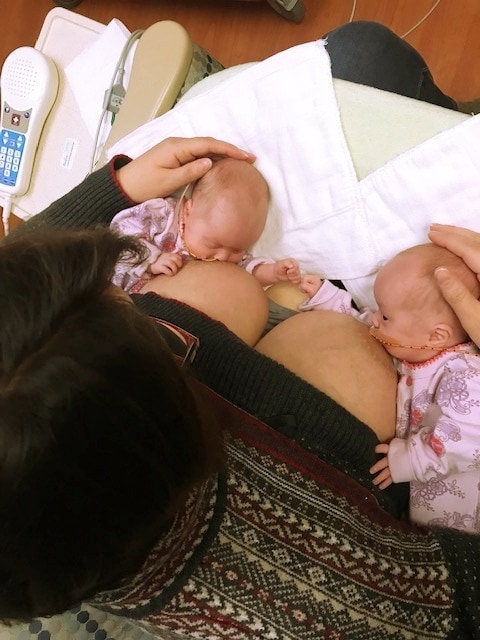
What I Can Do to Make Breastfeeding Twins Easier?
In the early weeks, there is not a whole lot you can do to make breastfeeding twins easier. It all gets better with practice. You and your babies are learning together, and it’s mostly trial and error. One thing you can do to help with breastfeeding twins is to give your babies tummy time every day. Tummy time helps your babies to get stronger core and upper body muscles, which will be helpful for breastfeeding. They will start to be able to lift their heads easier, pull themselves up easier, and that can lead to more successful tandem breastfeeding.
Having your partner or another adult helper nearby to help is another way to make breastfeeding twins easier. This person can bring you the babies when it’s time for them to eat, change their diapers, get them back down to bed, etc. This will put less pressure on you to do everything yourself. This is a great way to get your partner involved in overnight feedings — you shouldn’t be doing this all yourself if your partner is in the house with you.
What if My Twins Are Unable to Breastfeed?
If your twins are unable to breastfeed but you still want them to get your breastmilk, put yourself on a 3-hour pumping schedule. This milk can be fed to your babies through a bottle, tube feed, or cup feed. If you want to go with formula and ditch the pump, that’s OK too! As long as your babies are being fed, that’s what truly matters. pumping exclusively for twins is VERY, VERY common!
Should I Feed My Twins Together or Separately?
Babies tend to learn how to breastfeed easier and more quickly when it’s 1-on-1. We recommend that you wait until your twins are really good at breastfeeding individually before bringing them together to try tandem feeding.

Want to be the first to know about giveaways, deals, and more just for twin parents? Sign up for the Twiniversity email list! Subscribe today to get emails about giveaways, events, weekly article roundups, and more! Pregnant with twins? We’ll be sending you a weekly twin pregnancy email to keep you on track with your pregnancy to-do list! Click here to learn more… and while you’re at it, check out our Complete Baby Safety Course and Twin Parent Memberships.
I’m Struggling With Breastfeeding Multiples: What Should I Do?
If you’re struggling with breastfeeding your multiples, reach out for help. Talk to your pediatrician, obstetrician, lactation professional, postpartum doula, and other mothers of twins and multiples who have been there. They will help you to determine your next step, whether that be making adjustments to your plan, trying new products, or making the decision to stop. You don’t have to go through breastfeeding twins alone! Give yourself some grace and know that it will take time, work, and practice to figure it out.
Looking After Yourself
It’s so hard to think about yourself when you’re trying to keep two babies alive (been there, done that!) But it’s really crucial that you pay attention to any postpartum warning signs such as:
- signs of postpartum depression
- signs of postpartum anxiety
- problems with your C-section incision
- high or low blood pressure – which could be a sign of postpartum preeclampsia
- dizziness
- spotty vision
- swelling
- headaches
- pain in your belly
- shortness of breath
These symptoms can mean that something is really wrong. Don’t put off calling your doctor if you experience any of these symptoms.
Mixed Feelings About Breastfeeding Twins
It’s totally normal to feel like you’re not sure about breastfeeding twins. It’s a really hard job! There are a lot of ups and downs, and the pressure can feel very overwhelming at times. Just remember that you are NOT alone. Most moms of twins go through these feelings, and many of them make changes to their feeding plan over time.
There is no one right way to feed a baby. And you don’t have to stick to just one way of feeding. You can breastfeed, pump, and formula feed in combination — this is called hybrid feeding. You don’t have to stop nursing just because you start pumping or supplementing with formula. You need to do what works best for you and your babies. But most of all YOU. We want you to enjoy this time with your newborn twins and not feel like you hated every minute. Make changes as you go and always put yourself first. Read more about stopping breastfeeding your twins.
Different Positions for Tandem Breastfeeding Twins
There are so many tandem breastfeeding positions for breastfeeding twins. The most popular position for newborn twins is the double-clutch hold, aka double football hold. Each baby lays on their side, one on your right and one on your left. This position is great when they are very little because it allows you to have good control over their necks.
As your babies grow and develop stronger upper body muscles, you will be able to experiment with different tandem breastfeeding positions, such as the double-cradle hold, double cross-cradle hold, and double-cradle clutch hold. Check out this great article to learn more about tandem breastfeeding positions.
If you have an oversupply of milk and your babies are pushing away from you, change positions to slow the flow of milk. Mom should lay on her back with the babies on top to allow gravity to help slow the milk flow.
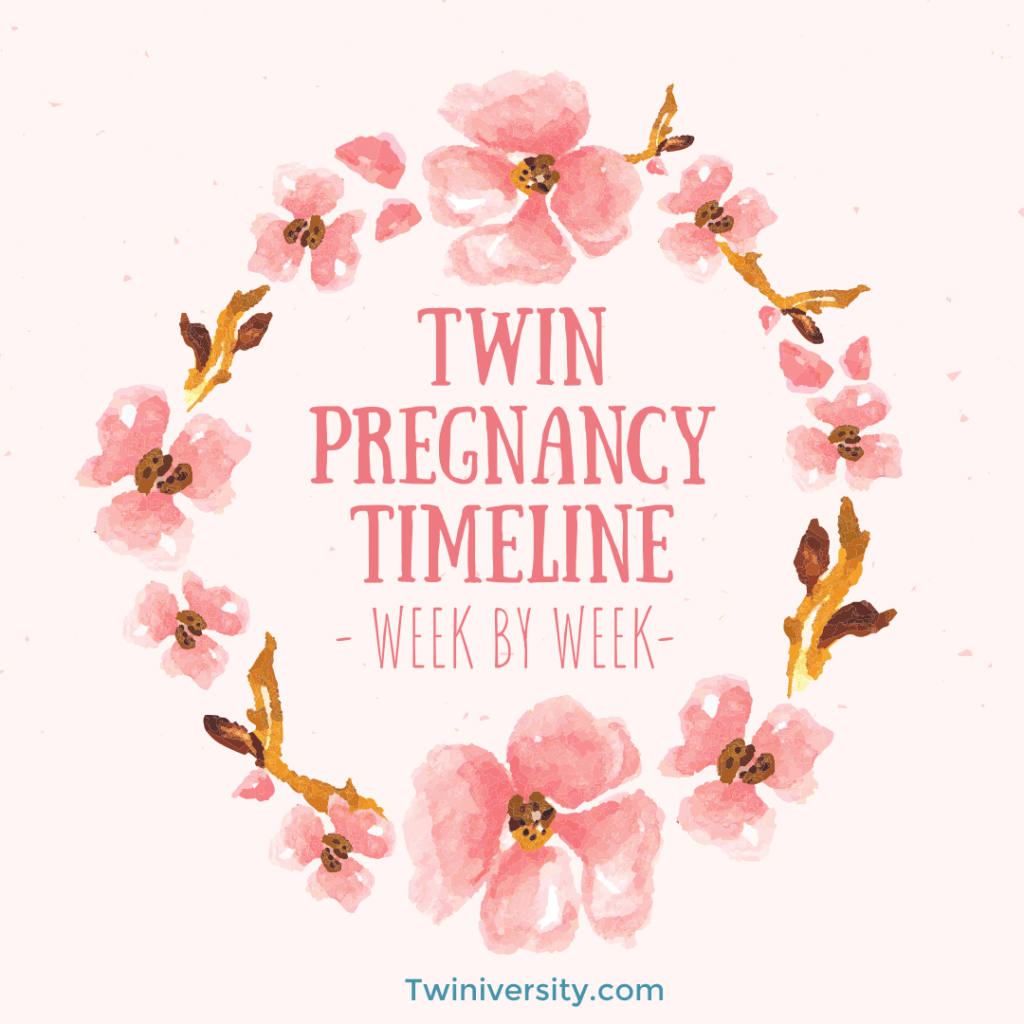
If you just heard that second heartbeat for the first time, or you know it’s been two for a while, you need to read our twin pregnancy week by week timeline to help you learn what happens week by week with twins. Click here to learn more… and while you’re at it, check out our expecting twins classes and twin parent coaching services.
Breastfeeding and Working Full Time
If you’re planning to go back to work while breastfeeding, you’ll need to prepare for pumping at work. Buy a second pump to keep at the office so you don’t have to lug it back and forth every day. Many insurance providers cover 2 pumps a year.
Ask your Human Resources Department at your work about a lactation room. If your company employs more than 50 people, they are required to provide a private space that’s not a bathroom for you to pump. Learn more about your breastfeeding rights at work. Make a plan with your boss on where and when the pumping will happen so you can plan a schedule for pumping. Mark these times in your work calendar as “busy” so your co-workers know to avoid those times when scheduling meetings. You can bring a cooler bag to store your milk in your office after you pump or store it in the communal refrigerator. Some moms buy a mini-fridge to keep in their office, which is also great for keeping snacks and cold drinks nearby.
Bring your milk home with you in a cooler bag every night. It’s really important to keep pumping while you’re at work to keep your supply up while you’re unable to nurse. The milk you pump can be given to your babies the next day while you’re at work.
How Many Calories Do You Need a Day to Breastfeed Twins?
You will burn about 400-500 calories a day just by breastfeeding one baby. When you have twins, double that. Eating an extra 1,000 calories a day and keeping yourself well hydrated should help to keep your energy level up for breastfeeding twins. Fun fact — the amount of food you eat and water you drink has no effect on how much milk you make. BUT the amount of food and water you get in a day will greatly affect your energy level and how well you feel. That’s why we recommend you always have a big water bottle and a basket of healthy snacks nearby.
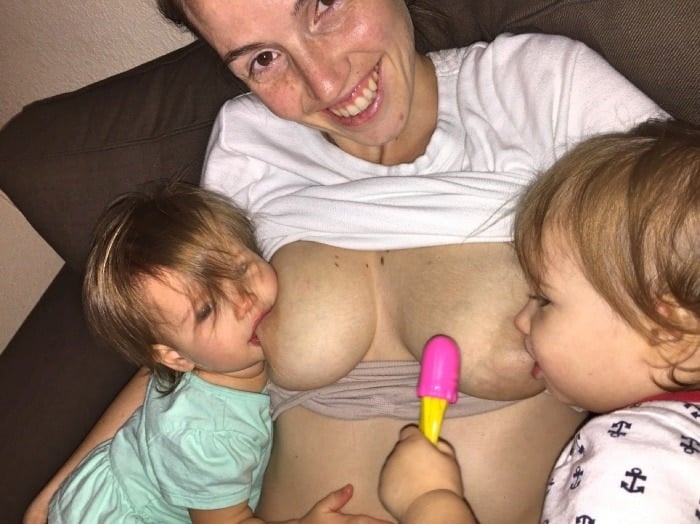
How Long Should I Breastfeed Twins?
If the breastfeeding relationship between you and your twins is running smoothly, breastfeeding can continue until your babies are several years old. Exclusive breastfeeding has been linked to improved immunity for baby. Even if you nurse for a short time, every breastfeeding session benefits your babies’ health. Extended breastfeeding for twins is more common than you’d think and not a lot of people talk about it.
However, if breastfeeding twins is not going well, and you are banging your head against a wall with frustration and finding yourself crying every day about it — I’m here to tell you it is OK to stop. If breastfeeding twins is bringing sadness to your life and you can’t enjoy your babies, it’s not worth it. Your babies will be fine. They will still develop immunities and grow as they should. You are not depriving them. You are not ruining their future. In five years from now you’ll see them running on the playground with their friends. Do you think you’ll be able to tell which kids were breastfed? No. Just make sure your babies are well fed and growing and you’re doing right by them. Raising twins is hard, momma! But you are doing it!
When you’re ready to wean, whether you tried for one day or four years, here are some tips to wean twins from breastfeeding.
If you need extra support, our Twiniversity team of experts can provide breastfeeding support and guidance to make sure you know how to best nourish your newborns with breast milk or formula so they grow up healthy and strong. Connect with us today!

